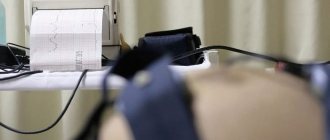The fetal heart begins to form even when the woman does not yet know about her pregnancy, namely at 1.4-2 weeks. At this stage, this important organ is nothing more than a hollow tube allowing the mother's blood to pass through it. But after a few more weeks, the fetal heart acquires all the indicators and functions necessary for life.
The heartbeat of the developing fetus is recorded already at the 4th week of intrauterine life , when the level of development of all other organs is still early.
Normally, the number of beats at this moment is 80-85 beats - this is the only indicator by which doctors can judge the absence or presence of abnormalities in the development of the embryo at this stage, since all other manifestations of the fetus’s vital activity, including active movements and tremors, appear at at a later date.
Doctors do not know the reasons that force a group of cells to produce a coordinated pulsation, but they have knowledge that helps determine the following indicators by its frequency and clarity:
- child's health level,
- indicators of fetal development in relation to gestational age.
With the further process of intrauterine development, the frequency and clarity of fetal heartbeats changes.
Normally, the indicators do not go beyond those presented in the following table:
| Trimester | Number of weeks | Number of heart beats |
| 1 | 2-4 | 80-100 |
| 1 | 5-7 | 120-160 |
| 1 | 9-14 | 160-180 |
| 2 | 15-20 | 130-160 |
| 2 | 20-26 | 130-160 |
| 3 | 27-31 | 130-160 |
| 3 | 33-40 | 140-160 |
Starting from the first trimester of intrauterine development of the fetus, its cardiac activity is carefully monitored by doctors, by regularly listening to the heart rate, recording it in writing, with further comparative analysis of the indicators.
At this stage, the weekly heart rate norms for girls are not much different from the same norms for boys.
Do you want to know the interpretation of fetal CTG?
When does fetal heartbeat occur?
Already during the 2-3 week period of a child’s development, his heart is formed in the mother’s womb. At this stage, a woman may not even suspect that she is pregnant .
The formation of the heart begins with its appearance in the form of a simple tube, which after a couple of weeks acquires an S-shaped bend. For this reason, this period in the development of the heart is called sigmoid. After 4-5 weeks, the primary septum appears, separating the atria, which leads to the appearance of three chambers in the structure of the small heart. From this moment its first contractions begin. Listening to a knock can only be done using an expert-class ultrasound machine . If there are no special indications for such early listening, it should not be used.
During weeks 5-7 of embryo development, an indirect indicator is used to determine the nature of embryo development - the level of the hormone hCG (chorionic gonadotropin).
For measurements, data are taken over time after 2-3 days. Normally, by week 5, the content of this hormone should fluctuate between 1000-3100 mIU/ml. If pregnancy develops normally in the early stages, then the level of this hormone will double every 2-3 days, then its low
Experts believe that analysis for this hormone can be reliable only up to the 10th week of pregnancy.
At later stages, it begins to fall, and its low content during this period corresponds to the physiological norm. This diagnostic method serves as an alternative to ultrasound at the very beginning of pregnancy. One of the fundamental characteristics during pregnancy, indicating its proper course, is the fetal heartbeat . One of the first methods used to study it by obstetricians is auscultation. It is a physical diagnostic method that allows you to determine the condition of an organ by listening to the sounds it makes.
Typically, the fetal heart is listened to using this method no earlier than 18-20 weeks of gestation. Until this time, the heartbeat is usually weak; in the early stages, for this reason, it is very difficult to hear without the use of special methods.
Formation time
As a rule, fetal heartbeat appears within 30 days after successful implantation. The fact is that of all organs, the heart is one of the first to form. Its formation occurs already from 21 days after conception.
To hear the heartbeat, a woman needs to visit an ultrasound specialist.
Note! Heart rate can only be determined in the early stages using a transvaginal sensor.
Starting from the third month of pregnancy, examinations can already be performed abdominally.
The number of contractions during normal pregnancy should be at least 80-100 and no more than 200 in one minute.
The time when the fetal heart begins to beat is usually the same for all women.
However, if at the first ultrasound it was not possible to hear it, but the fertilized egg in the uterus is visualized, you should not get upset prematurely.
The fact is that the date of conception may be set incorrectly and the heart muscle has not yet had time to fully form. The doctor will definitely prescribe a repeat test in 7-14 days. When the fetal heartbeat is heard on an ultrasound, we can confidently say that the pregnancy is not frozen.
It is worth noting that during the first ultrasound examination, the doctor may not hear what kind of heartbeat the embryo has if the study is performed on an old device. Therefore, it is best for a woman to go to a good clinic with high-quality medical equipment and experienced specialists.
At what hCG level can you hear a heartbeat? As a rule, in the middle of the second month after implantation, the level of human chorionic gonadotropin reaches 7200 IU/l. With this indicator, you can already see the fertilized egg in the uterine cavity, and distinguish the beating of the heart muscle that is not yet fully formed.
It is important to measure your heart rate during the first trimester. The fact is that it is in the first three months that congenital defects can occur in the embryo. As a rule, pathology appears due to the bad habits of the expectant mother, taking antibiotics, hereditary predisposition, severe stress and infectious diseases.
To try to prevent abnormal heart development in the child, it is recommended to plan conception in advance. A few months before pregnancy, you should completely get rid of bad habits, stop taking medications that can be toxic to the baby, eliminate coffee and tea from your diet, and try not to be nervous or worry about anything.
Fetal heart rate
Throughout pregnancy, the heart rate changes depending on the activity of the heart and the period of development:
- At 6-8 weeks it is no lower than 110-130 beats per minute;
- At 9-10 weeks – 170-190 beats/min.;
- Starting from the 11th and later weeks until birth, it is in the range of 140-160 beats/min.
Such changes are explained by the continuous development of the fetus, during which the functioning of the autonomic nervous system, responsible for the coherence of the work of all internal organs and systems, takes place.
For diagnostic accuracy, doctors use special tables that allow them to monitor whether the development of the heartbeat corresponds to physiological norms. What the heart rate should be at different stages of pregnancy can be found in Table 1.
Table 1. Physiological norms for the period of embryonic development and heart rate
| Week of pregnancy | Normal heart rate | Diagnostic methods |
| 5 | 90-110 | — |
| 42922 | 100-130 | Ultrasound |
| 42986 | 130-150 | |
| 43049 | 140-170 | |
| 41609 | 140-180 | |
| 14-15 | 140-170 | |
| 16-17 | 140-170 | |
| 18-19 | 130-170 | |
| 20-21 | 140-170 | |
| 22-23 | 130-160 | Cardiotocography on ultrasound |
| 24-40 | 120-160 | Ultrasound, CHT, Listening with a stethoscope (starting from 27-28 weeks) |
Purpose of fetal heartbeat detection
Listening to a baby's heart rate before birth is done for several reasons:
- To establish the fact of pregnancy. When a delay in menstruation occurs and a positive pregnancy test occurs, women undergo the first ultrasound. Sometimes the first ultrasound examination does not allow you to hear the heartbeat, which is not a reason to panic. The heartbeat will definitely appear later. You should be concerned if the knocking noise cannot be detected later during re-examination. This alarming symptom may indicate deformation of the ovum, which is quite bad.
It is called a frozen pregnancy, which is an indicator for a medical abortion due to complications.
- To assess the condition of the embryo. The baby's heart reacts sensitively to any changes in the world around him. Stress, illness or excessive physical activity experienced by the expectant mother cause changes in the oxygen concentration in the air surrounding the embryo and is reflected in the heart rhythms. Usually such changes are temporary. A rapid heartbeat indicates a violation of the blood supply to the fetus, called fetoplacental insufficiency. Often it becomes chronic, which does not lead to depletion of the baby’s compensatory capabilities.
Pathological changes that serve as signs of serious deterioration in the child’s condition are a slow heart rate, rare and muffled sound.
In these cases, the nature of the heart sounds determines the choice of treatment methods, and emergency delivery is undertaken.
- To monitor the condition of the fetus before birth . This stage is the most important for the development of the child in the womb. The baby, like his heart, experiences enormous stress, compression and lack of oxygen during childbirth. The physiologically determined stress resistance of the newborn’s cardiovascular system helps to cope. Danger can arise if the umbilical cord is pinched or placental abruption occurs. There may be other conditions that require emergency medical attention, which is why obstetricians measure the fetal heartbeat after each contraction. This measure allows you not to miss the symptoms of acute oxygen deficiency.
How can you listen to the beat yourself?
If you are interested in how to listen to the fetal heartbeat at home, you should know that in the early stages it is impossible to do this on your own. In the first and second trimesters, this can only be done by a specialist using special equipment.
DETAILS: Bradycardia - symptoms, treatment, causes, bradycardia in children
Popular methods for listening to the fetal heartbeat at home:
- Fetal Doppler, which can be used from the second trimester. This ultrasonic detector provides fairly accurate results. However, the cost of such a device is high.
- Starting from the third trimester, the expectant mother can independently listen to the baby’s heartbeat using a stethoscope. However, in some cases this cannot be done. For example, hearing the beat frequency may be difficult due to the mother's thick abdominal fat or large volume of amniotic fluid.
All of the above devices are absolutely harmless to the embryo. However, the baby often feels the radiation emanating from the device and always tries to move away from its rays. If a woman feels the baby is restless, it is best to postpone the measurement until the baby calms down.
Methods for diagnosing fetal heartbeat
Fetal weight by week of pregnancy
The main methods for diagnosing the heartbeat of an intrauterine child are:
- Ultrasonography;
- Auscultation;
- Cardiotocography (CTG);
- Echocardiography.
Ultrasound is the very first method used to study the condition of the embryo.
Stages of development
Using this method, the following are studied:
- Heart rate;
- Fruit size;
- Condition of the placenta;
- Heart sounds;
- Structure of the heart;
- Possible defects, as well as other anomalies, if there are reasons for their occurrence.
Features of ultrasound are shown in Table 2.
Table 2. Ultrasound technique at different stages of pregnancy
| Deadlines | weeks | Sensor used | Indicators | Possible pathologies | Recommendations |
| Early dates | 5-6 | Transvaginal | Number of heartbeats | Non-developing pregnancy | Repeat ultrasound in 5-7 days |
| 6-7 | Transabdominal | ||||
| II and III trimesters | From 12 weeks | Number of heartbeats; | Possible heart defects | Application of the “four-chamber slice” technique | |
| Their frequency; | |||||
| The position of the baby's heart in the chest; | |||||
| Structure of the atria and ventricles |
The auscultation technique involves listening to the following signs:
- Heart rate;
- Clarity of tones;
- A place to listen to them in the best possible way.
The advantage of this method is that it can be used by a person without special education. Using a medical tube, you can easily hear heart sounds and count their number per minute using a stopwatch.
It is important to understand what heart sounds are and their significance as an indicator of fetal development. The normal development of the child's body should be accompanied by clear and distinct sounds of the heartbeat.
If the tones become dull, then this may be a sign of acute and chronic hypoxia.
In rare cases, poor listening tone occurs, which is a sign of the need for additional examination methods.
Other methods are also prescribed if:
- There are changes in the volume of amniotic fluid (increased or decreased);
- In case of multiple pregnancy;
- The woman is overweight and the thickness of the subcutaneous fat cell of the anterior peritoneum does not allow the use of auscultation;
- The placenta is located at the anterior wall.
The cardiotocography method is very informative for assessing the quality of the heartbeat. When used in the early stages, it is possible to detect the presence of oxygen starvation in the baby so that the necessary measures can be taken. It is usually prescribed after the 32nd week and before birth.
The machine used in this procedure is an ultrasonic transducer. The signals sent from it are reflected from the heart of the embryo. The changes that occur are recorded on a special film.
Typically, in addition to the main sensor, the doctor uses a contraction sensor in the uterus, which makes it possible to measure its activity, which is of particular importance during childbirth.
Modern devices also have special sensors that record fetal movements, which a woman can even do independently. The received information is also displayed on the tape. Recording using this method is carried out with the woman lying on her back. Due to the fact that in the later stages this causes great inconvenience, it may be recommended to take a sitting or lying position on your side.
For this purpose, the sensor is installed on the stomach, where the point of best listening to tones must first be found. The entire procedure is carried out in 40-60 minutes. In some cases, the sensor can be left for a day.
The following indicators are assessed using this method:
- Fetal heartbeat and characteristic changes that occur during contractions in the uterus.
- Heart rate.
- The dynamics of heart contractions (that there are no violations will be indicated by changes in the number of beats within 25 per minute).
- The appearance of a rapid rhythm in response to contractions in the uterus, which should not occur normally.
- The appearance of rarer contractions is taken as normal in the pelvic position of the fetus, but may also indicate acute or chronic hypoxia in other cases.
Pregnancy weight
During pregnancy, CTG is prescribed to each woman at least once.
According to the standards for this method, which establish how the heart should beat, doctors believe that 120-160 beats should be recorded per minute.
There are a number of indications for repeated mandatory use of this method:
- Late gestosis.
- The presence of a scar on the uterus due to surgery.
- Changes in the volume of amniotic fluid.
- Previous infectious pathologies in which a high temperature was observed.
- Chronic maternal illnesses (diabetes mellitus, arterial hypertension).
- Premature aging of the placenta.
CTG
If a detailed study of the structure of the fetal heart and the characteristics of blood flow in its different parts is necessary, echocardiography is prescribed if indicated. It is usually carried out at 18-28 weeks.
Indications for its implementation may be the following:
- Existing congenital heart defects in a woman.
- Birth of previous children with congenital defects.
- When a woman is over 38 years old.
- Infections during pregnancy.
- Presence of diabetes mellitus.
- Observed delays in intrauterine development of the embryo.
- Suspicion of the presence of defects in the fetus of both the heart and other organs, which may be combined with disturbances in the development of the heart.
Fetal Doppler is also used as a technique for studying the heartbeat. This is a portable device that you can use at home yourself. The principle of its operation is similar to CTG, but without recording on film. It comes with headphones, allowing you to listen comfortably at home.
You can hear the baby’s heartbeat as early as 8 weeks, but experts recommend using it later, after 12 weeks, if necessary. The duration of the study should not exceed 10 minutes.
Table 3. Pros and cons of portable Doppler
| pros | Minuses |
| you can listen to the fetal heart already at 8-12 weeks; | very expensive; |
| easy to use; | - has some limitations in use; |
| does not require an assistant for a pregnant woman. | requires compliance with safety measures, and is not always suitable for frequent and prolonged use. |
Can you feel the beat through your stomach?
Regardless of the stage of pregnancy, a woman
the heartbeat of the unborn baby.
What she mistakes for heartbeats is only the pulsation of her own aorta, which occurs as a result of increased pressure in this vessel.
DETAILS: Episodes of fetal bradycardia
A surge in blood pressure occurs due to serious hormonal changes occurring in the female body.
If a woman feels something similar to a heartbeat through her stomach, she must definitely contact a gynecologist, who, after a thorough examination, can refer her for a consultation with an experienced cardiologist.
Is it possible to hear the fetal heartbeat yourself at home? It is quite difficult to do this without the help of specialized medical equipment. Fortunately, today you can purchase devices that will allow you to hear the heartbeat of your long-awaited and already beloved baby already in the third trimester.
Is it possible to determine the sex of a child by heart rhythm?
In order to determine the sex of the unborn child, there are a number of traditional methods, which in most cases are rejected by doctors.
Palpitation is an important sign according to traditional medicine in this matter:
- By listening to the heart rhythm week by week, you can determine whether the birth is a boy or a girl, depending on the clarity and rhythm. Usually this is how a boy’s heart beats, while girls’ hearts beat more chaotically, not coinciding with their mother’s.
- Based on the location of the heart, a little to the left predicts the birth of a girl, and a little to the right - a boy.
- By how many heartbeats occur per minute, you can determine the gender of the unborn child:
Table 4. Number of heart beats in embryos of different sexes
| Gender of the unborn child | Number of heartbeats per minute |
| Boy | More than 150 and less than 140 |
| Girl | More than 160 and less than 120 |
Listening to the heartbeat of an unborn child is an important method for diagnosing the state of his health. It should be used throughout pregnancy.










